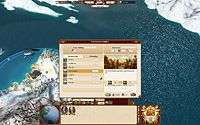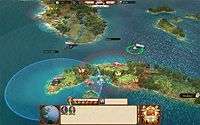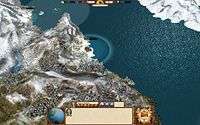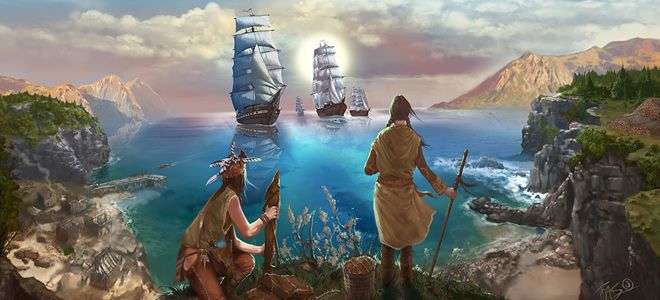Commander: Conquest Of The Americas Review
by Mark R
|
 Back in 1983, as an eleven year old Alan Sugar wannabe, I had a particularly unhealthy obsession with an Oric-1 trading game called “Candyfloss” which looked remarkably like Channel 4′s old Oracle teletext in that it was primarily text based and had brightly coloured blocks attempting to depict, presumably, Blackpool. The premise was simple – buy sugar at the best possible price before turning it in to candyfloss, then market it to the holidaymakers on the sea front to turn a healthy profit and, if you were really lucky, there would be workmen on the promenade who would buy all your candyfloss, regardless of the price. It was remarkably simple, as well as nauseatingly difficult at times due to the random nature of the buyers but, I have to admit, I was utterly hooked and I spent more time with that game than most others. That was my first, and last, outing with trading games and I went on to spend the next two decades concentrating more on sim and strategy games.
Back in 1983, as an eleven year old Alan Sugar wannabe, I had a particularly unhealthy obsession with an Oric-1 trading game called “Candyfloss” which looked remarkably like Channel 4′s old Oracle teletext in that it was primarily text based and had brightly coloured blocks attempting to depict, presumably, Blackpool. The premise was simple – buy sugar at the best possible price before turning it in to candyfloss, then market it to the holidaymakers on the sea front to turn a healthy profit and, if you were really lucky, there would be workmen on the promenade who would buy all your candyfloss, regardless of the price. It was remarkably simple, as well as nauseatingly difficult at times due to the random nature of the buyers but, I have to admit, I was utterly hooked and I spent more time with that game than most others. That was my first, and last, outing with trading games and I went on to spend the next two decades concentrating more on sim and strategy games.
When Commander: Conquest Of The Americas (hereafter known as CotA) turned up at GamingLives HQ I was understandably quite sceptical because, let’s face it, with the amount of tech at our fingertips these days, the majority of gamers would want to get their teeth sunk in to more than just buying from one source and selling to another. Trading games are great, although their appeal is generally limited to those with a particular leaning but the strong sense of hybrid between real time strategy, management game and battle simulation gave me that little spark of excitement that I still get today from UFO: Enemy Unknown which is, on the face of it, similar in terms of the mechanics apart from the real time aspect. With that in mind, any trepidation dissipated quickly as I began my journey to dig my heels firmly into the soil of the New World and, eventually, rule the colonies.
 According to the Finnish developers, Nitro Games, CotA is not only the natural successor to their previous release, East India Company, it’s more akin to being an entire evolution of its predecessor. After listening to feedback from East India Company fan base, Nitro have taken the gameplay mechanics of the previous game and greatly improved on the functionality as well as including features which were originally due to be included in EIC but never made it to the final release. That’s not to say that Nitro Games had a false start with EIC, but had simply taken great steps to ensure that the end users get everything that they asked for when the next game rolled out, and that’s exactly what we have in CotA.
According to the Finnish developers, Nitro Games, CotA is not only the natural successor to their previous release, East India Company, it’s more akin to being an entire evolution of its predecessor. After listening to feedback from East India Company fan base, Nitro have taken the gameplay mechanics of the previous game and greatly improved on the functionality as well as including features which were originally due to be included in EIC but never made it to the final release. That’s not to say that Nitro Games had a false start with EIC, but had simply taken great steps to ensure that the end users get everything that they asked for when the next game rolled out, and that’s exactly what we have in CotA.
It is, perhaps, the best time to bring up something vital to the enjoyment of this game: there is no tutorial and the manual is more or less a clone of all the in-game tips, therefore you’re pretty much on your own to fumble around and work out how everything works through trial and error. It actually got to the stage where, after an hour of continually pausing the game and switching over to a browser, I called someone else through (with more experience on games such as Colonization and Civilization) to ask if I was just taking a completely braindead approach and missing the obvious. It turns out that I wasn’t entirely to blame and, although we managed to work out what to do between us, the icons and controls aren’t exactly what you’d describe as intuitive, the popup tool tips weren’t present for all areas, and I had almost reached that point where the game would have been classed as unplayable. Before you all give up now and decide not to waste your time on the game, let me just say this to you: from the point where I first took control of my vessel until my last save of the evening was a staggering thirteen hours… and it was thirteen hours that I never noticed passing. This game IS worth struggling beyond the lack of a tutorial, which you’ll find out as you read on.
 |
 |
 |
 |
 |
 |
The year is 1500 and, equipped only with a small crew and a huddle of wary colonists, you take command of your first ship to seek out the best possible place to start your first colony before any of your six opponent countries beat you to the chase for the best resources. As your ship cuts through the ocean towards land, any potential colonies nearby are highlighted on screen allowing you to sail over to see which resources would initially be available to you, as well as those which would become available as you expand the growth and reach of the colony over time. Your ability to build your initial colony is, as expected, hindered by structural prioritising to prevent you from doing too much too soon and so the first step is to collect whichever raw materials are available from the immediate vicinity with a view to selling these on, thereby funding the growth of your first colony and, ultimately, your domination of the Americas.
Being set 500 years ago means that you are denied the luxury of supercharged construction times so all those years of click-watch-ready building in games such as the Command And Conquer series won’t have come close to preparing you for the 24 month build times of a level three Town Hall or the SIXTY month wait for level two Palace. This means that you have to treat every construction order with as much thought as you would a vital play in chess, thinking ahead to which building you may need before any other, and forfeiting potential strategies in the process. While this may work without any real consequence in sandbox mode, the campaign mode has the added hurdle of four separate advisors who will periodically jump in to tell you that they’re unhappy with your performance and that you need to quickly pull a rabbit out of the hat to appease them… a rabbit which, invariably, is outwith your current reach thanks to either not being able to build sea-going vessels quick enough or the fact that your building queue is already underway and stopping production of a particular build would still not leave you enough time to satisfy their requirements. Having said that, however, the added pressure of having men in wigs whispering in your ear makes the whole process more immersive than the proverbial laid back attitude of a sandbox environment.
 As well as massive queueing restrictions with the build process, there are certain facets of the production plants which can’t be accessed until you reach a specific year. An example would be that, if your colony has tobacco as one of its available resources, you have several years ahead of you to trade nothing but the raw materials before your build queue allows you to order the construction of a Cigar plant which, in turn, allows you to sell the finished product at a much greater price than the harvested tobacco leaves.
As well as massive queueing restrictions with the build process, there are certain facets of the production plants which can’t be accessed until you reach a specific year. An example would be that, if your colony has tobacco as one of its available resources, you have several years ahead of you to trade nothing but the raw materials before your build queue allows you to order the construction of a Cigar plant which, in turn, allows you to sell the finished product at a much greater price than the harvested tobacco leaves.
The growth of your shipping fleet is similarly hindered, with new vessel types being locked until you reach a specific year. This, as you would imagine, makes conquering other colonies much more difficult when you’re bobbing up and down in an overgrown rowing boat, throwing rocks at a colony which is already well armed with a garrison and fort. After a few decades the more powerful ships become available, with the first noteworthy being the trusty Galleon, and you can then start risking your crew to overthrow existing colonies for their resources and wealth. Each Commander has the power to control up to five different vessels as part of his fleet, from the choice of trade ships or war ships as well as a mixture of both, and it’s possible to group three fleets together to provide a formidable force against warring factions. During the build process of the ships, there is an additional option of three separate upgrades for each ship which will be installed at the time of building but each of these upgrades extends the build time by another month which, in the case of even a simple Galleon, can mean eleven months instead of eight… so if you’re planning on building an entire fleet of five, be prepared to wait almost five years for completion.
 Even with five or six separate colonies building a fleet of warships, to build a STRONG fleet (even after the first fifty years or so with Galleons as the strongest vessel available) can still take an inordinate amount of in-game time but, much to my own surprise, the wait was more than worth it. As the fifteenth Galleon finished construction, one my advisors told me that I just wasn’t working hard enough to bring a variation of goods to the home port and dictated that I should immediately colonise an area with sugarcane as its main resource. I say “immediately” but, while I had two years to fulfil this demand, all of the available colonies had been taken between my own player (Britain) and the other six nations, plus the amount of time required to gather the three fleets into formation to attack an existing colony would literally have meant only a three or four month margin of error.
Even with five or six separate colonies building a fleet of warships, to build a STRONG fleet (even after the first fifty years or so with Galleons as the strongest vessel available) can still take an inordinate amount of in-game time but, much to my own surprise, the wait was more than worth it. As the fifteenth Galleon finished construction, one my advisors told me that I just wasn’t working hard enough to bring a variation of goods to the home port and dictated that I should immediately colonise an area with sugarcane as its main resource. I say “immediately” but, while I had two years to fulfil this demand, all of the available colonies had been taken between my own player (Britain) and the other six nations, plus the amount of time required to gather the three fleets into formation to attack an existing colony would literally have meant only a three or four month margin of error.
Thankfully, I was able to rally the troops to a French colony which had sugarcane, whaling and spices as the available resources and I did the unthinkable: a tactical save, also known as a “just in case I end up losing all my ships” save. As this was a sea-to-land attack on a colony with 1000 soldiers garrisoned in a fort, with my side having only fifteen Galleons and a total of 750 soldiers (50 per vessel), I opted for the auto-resolve with the greatest damage being done to the enemy, as well as to my own troops. The result was a win for my country and so I not only managed to expand my list of colonies before I met the required population quota for expansion, but I also managed to add sugarcane, whaling and spices to my growing list of resources… unfortunately, not within the allocated time. Failure yet again, but so much fun in the process.
The battle aspect of the game then became more prevalent as, until that point, it was easy to get caught up in furthering the manufacturing processes and setting up countless automatic trade routes to allow you to manage the growth of each individual colony’s industry while the trade routes worked in a continual loop of picking up new colonists or soldiers from the home port, ferrying them to the designated colony where they would be dropped off and any new finished products picked up to sell back at home port for profit. After the conquest of the French colony, however, Alan Sugar was quickly kicked to the kerb to make way for Genghis Khan and my priority was to completely extinguish France before moving on to pick off each subsequent faction.
 |
 |
 |
 |
 |
 |
The battles are played out in three different modes: direct combat, real time strategy and auto-resolve. For those of you who dream of sailing the high seas at the helm of tall ship, then the direct combat mode is undoubtedly for you – standard WASD keyboard controls coupled with on-screen choices of ammunition type, similar to Sid Meier’s Pirates and, while this was fun to try out as part of the review, it’s not something that I’d normally opt for I was happy to hand the controls over to the AI. This brings us to the second combat mode, the realtime strategy approach, whereby your ships continue the pursuit of the enemy and you have the ability to control their direction and targeting using the on-screen icons or hand the choice of ammunition over to the AI depending on what would best suit the situation. Again, we come to the fact that the game is set 500 years ago where moving several tonnes of timber relied solely on the power of the wind… so it can take a considerable amount of time to actually reach the enemy, let alone sink them. The third combat option is the auto-resolve which is, as you’d expect, based on “your stats vs their stats” and the result is more or less a probability calculation, so the outcome of the battle occurs as soon as you click on the “auto-resolve” button – ideal if you want to progress without the added immersiveness of the one-to-one battle system.
In terms of graphics and handling, CotA performed admirably on a rather outdated AMD Athlon Dual Core 6000+ with two Nvidia 8800 GTS 640mb cards which was built in January 2008. With the resolution at 1920 x 1200 and all of the textures set to the highest quality, the texture mapping on the land and sea were outstanding and the level of detail in the individual vessels and colonies was better than expected. To maximise the performance I admit to sacrificing the texture quality somewhat by reducing it to the medium setting although, to be perfectly honest, it didn’t affect the overall look and feel of the game so it wasn’t a noticeable distraction. Had the game not required Steam to activate and play, it would have been played on a quad core Intel with an Nvidia GTX 295 through an InFocus IN83 projector and I can’t imagine how stunning it would have looked. For being a top-down strategy-trade hybrid, Commander: Conquest Of The Americas kicks some serious ass with the aesthetics.
The musical score is truly haunting and perfectly conveys the nautical and historical theme without ever sneaking in any modern day nuances, thereby placing you firmly in the past during gameplay. At times, I found myself swelling the volume considerably as I was enjoying the music so much and, even hours after playing, caught myself humming or whistling the main theme. It was, in my mind, similar to the type of theme you’d expect from Alan Silvestri… haunting, melodic, all encompassing and perfectly suited to the subject matter- the perfect way to polish off a game of this type. Fantastic.
Pros- More than just a trading game or a real time strategy
- Immersive gameplay
- Considerable amount of thought required to properly progress
- Choice of combat types
- Beautiful score
- Graphics were unexpected eye candy
- Realistic build time frames
- Realistic build time frames!
- Absolutely NO tutorial
- Would have liked to click on a colony to see what level of fleet was required to overthrow
- Doesn't seem to be any consequence from ignoring a colony's needs
Commander: Conquest Of The Americas as, in short, a superb hybrid of the best types of trading, management and real time strategic combat games. As soon the first vessel leaves port for the home port, stocked with products and returns to port with more colonists and soldiers, it's too late to let go as it has already stretched it's fingers deep inside you and won't let go. Although it can take a considerable amount of time for the colonies to grow, the satisfaction gained from conquering and taking over an established colony from one of the other six factions is worth the wait. The frequent missions from the four advisors serve to keep you on your toes so you don't lose sight of the main objective... expanding your colonies and keeping everyone working towards the same end. Overall, I can see this game swallowing a good 10-12 hours per day and you won't even notice the time passing, which is surely the sign of a great game.
Last five articles by Mark R
- From Acorns to Fish
- Alone In The Dark
- Why Borderlands is Better Than Borderlands 2
- Falling Short
- The Division: A Guide to Surviving the Dark Zone Solo

























Awesome review. To my shame, I have never played a game of this kind before. A combination of not having the right type of rig to run it and also just not having the aptitude to do this kind of game justice. A game set 500 years in the past, where you can become an industrial revolution-type Rupert Murdoch piques my interest. If my humble Dell Inspiron can take the strain, I may treat myself ot my very first PC-only game.
This appeared to be very much in the same vein as Colonization – a game that I loved for the Amiga, though with stunning visuals. When I saw the water effects I was impressed and thanks to you playing this, the music is now stuck in my head. This sort of game always appeals to me, though it seemed very much n00b unfriendly, largely thanks to the lack of tutorial. However, anyone who is a fan of these sort of games should get along fine with it. Great stuff and awesome review.
Quite tempted to have a look at this, can’t beat a bit of immersive gameplay! Could well tie me over nicely until Civ V rears its head
Great review dood and I’m sorely tempted to give it a go! Not sure I have the attention span for it though… especially with RDR, Need For Speed: Shift, Borderlands and some new DLC coming!
hmmm…. will put it on the list of possibles!
Visually stunning game though eh?
I was tempted to pick this up a while ago. Graphically it looks great, but that type of game is really hit or miss with me. I remember picking up Anno 1602 i think, one of the anno games and for a while it was ok. Then your into like four hours of trading and your still struggling to for tools Gives me a sore head sometimes.
Gives me a sore head sometimes.
With any luck, I’ll get to play this again tonight… got some work to do, as always, but I may manage to wrangle another couple of hours out of it. When I first started playing it, I actually thought to myself “Yeah, good game but I can’t see me longing to play it after I close down the PC” which was the same sort of thoughts I had with Alien Breed: Impact at the time… yet here I am, looking forward to playing it again. I need a clone. And a cone.. that’d be nice too… some ice cream on a hot day mmmmm
I’m afraid of this game now.
I need a handholding mode before I’ll even attempt anything more complicated than, say, Rebelstar Raiders.
Also a PC that wasn’t allergic to electricity would be a bonus also!
Still, good review Marko.
Amazing review, Markuz!
However, the game seems way too slow-burn for me to enjoy it, along with what seems like harsh margin of errors, and a lack of hand-holding may end up in too much wasted time for me when I have way too much else to play =/
[...] we discovered when we reviewed Commander: COTA a few weeks ago, the lack of a tutorial mode hiked the game’s difficulty curve in early play [...]